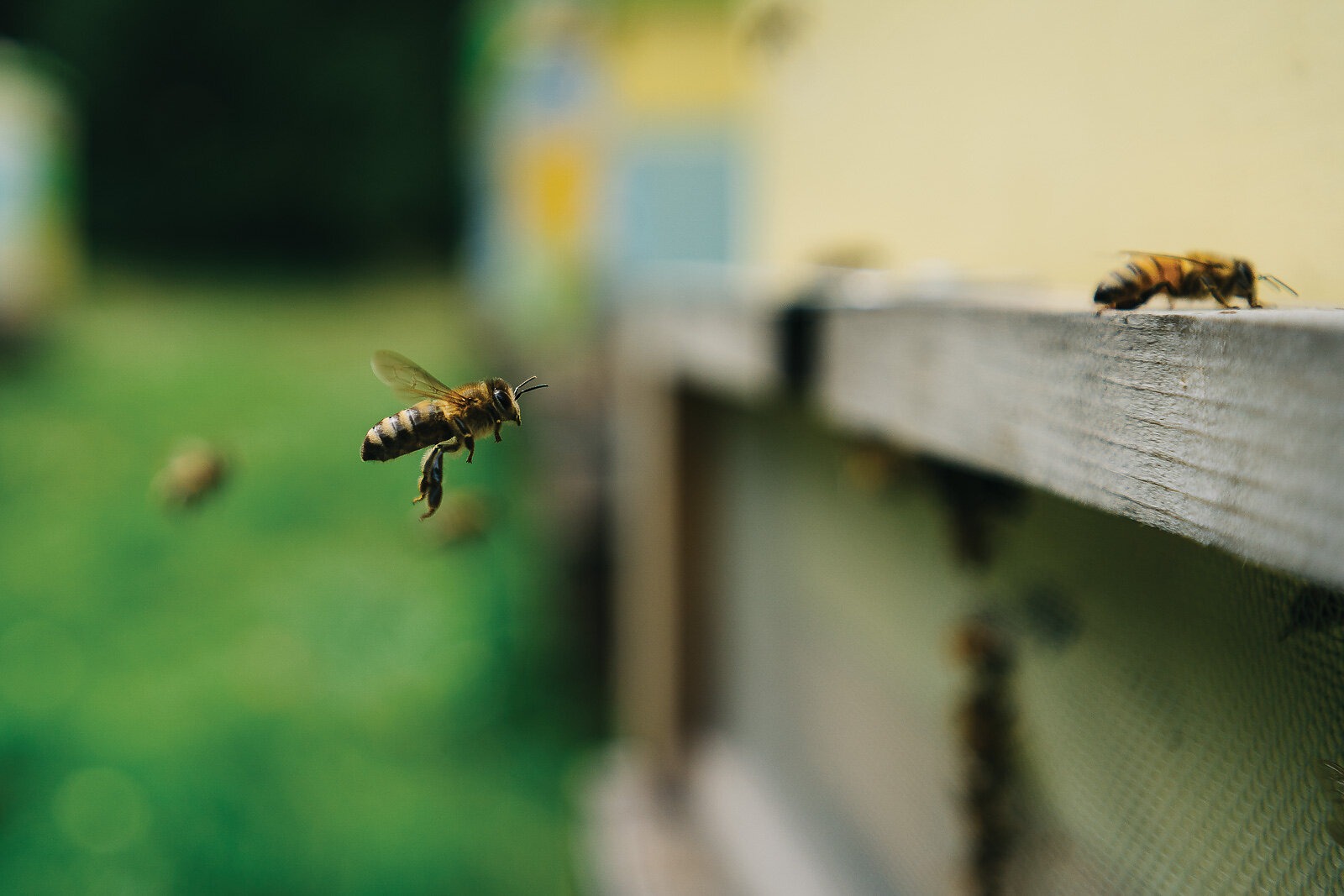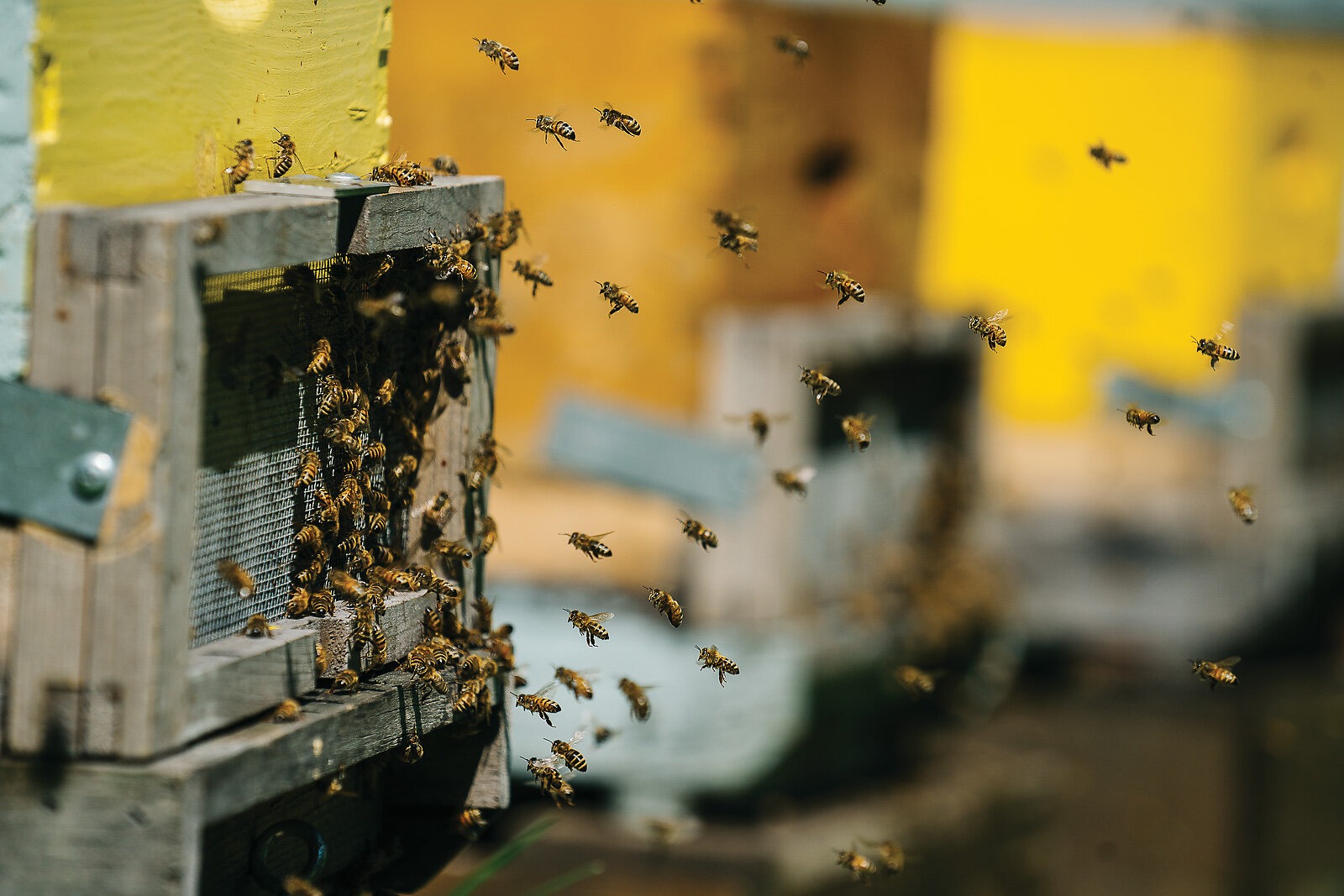
Pleas for the Bees Michael Jaross, Bellingham, WA’s Beekeeping Guru, is Helping Local Colonies Adapt
Words by Jann Eberharter | Photos by Skye Schillhammer
Between April 2019 and April 2020, more than 40 percent of honeybee colonies within the United States died off,
according a survey published by the Bee Informed Partnership. Additionally, that annual loss number has been hovering between 30 and 45 percent for the past decade.
For Bellingham, WA-based beekeeper Michael Jaross, this is a fact he drops relatively nonchalantly as he gives a tour of one of his hive clusters—yet it is the impetus for his unique take to the craft. The site, commonly referred to as the Dollar Lot and run by Judy and Tony Tilley, is just off Galbraith Lane and is always bustling with mountain bikers heading out on or returning from rides. But beyond the property’s garden are a dozen-plus stacks of pastel-colored boxes, each home to a honeybee colony, that tend to go unnoticed.
A lot of times, come spring, Jaross says, beekeepers will order new colonies through the mail if they had one die off during the winter. While this establishes a new colony for the time being, it often fails to contribute to the overall health of the local population, as the purchased bees aren’t acclimatized to their new environment. Jaross’ main goal as a beekeeper is to help establish that healthy local population in Bellingham, and that means working with other beekeepers to ensure their colonies thrive in the summer and survive the winter. To help accomplish this, he offers an eight-week-long beekeeping course, and sells colonies and queen bees.
Honeybees are native to the Mediterranean and were imported to North America in the 1600s. Since then, they’ve been adapting to the various climates of their new home, although it’s often a hard-fought battle. In recent years, the species faces its biggest challenge in the Varroa destructor, a mite that has been a significant factor in the alarming die-off rate. While a majority of the United States’ honeybee population is found in large-scale industrial bee farms, it’s often local beekeepers who are really able to help populations localize.
Each spring, as bees collect pollen from their goto favorites, like the Himalayan blackberry bushes and purple fireweed flowers that are abundant around the Dollar Lot, they transfer the pollen necessary for the plants to reproduce. This inadvertent effect of their collecting just about makes the world go ’round. About three-fourths of the flowering plants and more than a third of crops on the planet rely on pollinators—like bees—according to the United States Department of Agriculture.

When summer hits, it’s peak production time for the bees and equally busy for their handlers. Beekeepers don’t get summer vacations, Jaross says with a laugh while donning his all-white bee suit and its comically oversized mesh hat. Next, he lights some black walnut leaves and pine needles on fire, which he drops into his smoker. The scent, when puffed into the bee boxes, acts as a slight sedative, calming the bugs so he can look in the hive without being met by an angry swarm. Prying apart the sticky boxes and slowly brushing the bees aside, he looks in to check on the health of the hive and the current state of honey production.
Throughout his years in the bee game, Jaross has been strengthening his populations—and those of Whatcom County—by helping facilitate their natural selection. If one hive has a productive honey season, he’ll generate new queen bees from that population’s larvae in hopes their future hives will also produce well.
At the height of each hive’s production season, which is midsummer, it will have 35,000-40,000 bees. During summer months, as bees literally work themselves to death, their lifespans are about 4 to 5 weeks. In the winter, the bugs will live six months or so, as they aren’t nearly as active. With honey-making season coming to a close, Jaross is preparing to harvest the sweet gooey goodness in mid-to-late-August.
Due to the small scale of operations like Jaross’ and the time-intensive nature of the pursuit, the local community must see more value in the art of beekeeping than simply its sugary yields, he says. And in his experience, as evidenced by numerous passionate local beekeepers and the generosity of land-donors like the Tilleys, this little mountain- bike town does see it as something of significant importance. As Jaross shares his knowledge and helps these insects thrive, the region’s entire population slowly becomes more adapted to its habitat—and thus, more likely to survive.